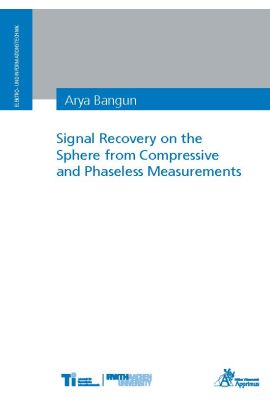In this thesis, we investigate the possibility of reducing the number of measurements and using only their magnitudes to reconstruct spherical signals and their three-dimensional rotations. These problems appear, for instance, in spherical near-field (SNF) antenna measurements, where the number of samples to acquire a signal implies a long measurement time and occasionally unreliable phase information.
We tailor the compressed sensing (CS) approach to reconstruct spherical signals from fewer measurements. Instead of considering fully random sensing matrices like in the typical CS, we restrict the randomness to follow certain structures derived from the properties of spherical harmonics and Wigner D-functions. In this setting, we provide a bound on the number of measurements required to allow stable and robust signal recovery as well as numerical evaluations to verify these results.
Although we limit the randomness, applying random sampling on the sphere is still cumbersome since collecting samples requires the use of mechanical devices that move smoothly over the spherical surface, such as robots. Hence, a deterministic sampling pattern to construct sensing matrices is still desired in many applications and the notion of coherence is used to measure the sensing matrices’ quality. First, we show a class of commonly used deterministic sampling patterns on the sphere that produces the worst coherence sensing matrices and, thereby, is unsuitable for CS. Subsequently, we propose a sampling strategy on the sphere to construct low coherence deterministic sensing matrices from spherical harmonics and Wigner D-functions, and derive a coherence bound for both cases.
Apart from dealing with compressive measurements, we also study signal recovery on the sphere from phaseless measurements and identify some potential ambiguities under this setting. We analyze ambiguities which arise from the properties of complex and real spherical harmonics, as well as the ambiguity caused by the implementation of inappropriate sampling patterns. As a further contribution, numerical evaluations are conducted to compare several reconstruction algorithms as well as the effects of different sampling patterns on the sphere.
Finally, these results are implemented using SNF data, where we numerically show that our proposed sampling pattern requires significantly less number of measurements to provide high-quality reconstructions of far-field patterns when compared to classical approaches.
| Autor | Bangun, Arya |
|---|---|
| Lieferzeit | 3-4 Tage |
| Gewicht | 0.23 kg |
| Erscheinungsdatum | 13.03.2020 |
Lehrstuhl für Theoretische Informationstechnik (TI)
Signal Recovery on the Sphere from Compressive and Phaseless Measurements
Kurzbeschreibung
In this thesis, we investigate the possibility of reducing the number of measurements and using only their magnitudes to reconstruct spherical signals and their three-dimensional rotations. These problems appear, for instance, in spherical near-field (SNF) antenna measurements, where the number of samples to acquire a signal implies a long measurement time and occasionally unreliable phase information.

